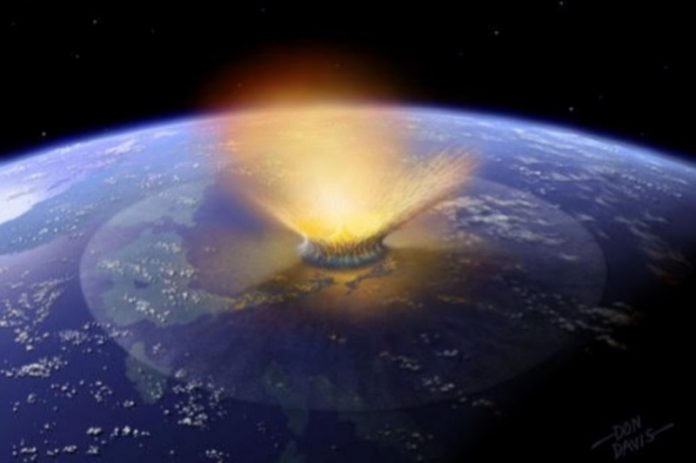
An asteroid impact 66 million years ago may have released trillions of pounds of partially burned fossil carbon into Earth’s upper atmosphere as a cloud of black soot, significantly contributing to the ensuing global darkness, cooling and mass extinction that wiped out the dinosaurs, according to an international team of scientists.
“Following the impact, a massive amount of rock was ejected and vaporized, and the burned carbon from that rock made it into Earth’s upper atmosphere within an hour or so,” said Shelby Lyons, who led the research as a doctoral student at Penn State.
“This would have exacerbated global cooling and darkness and been one of the major causes of the mass extinction when you couple it with sulfur and dust that also made it into the atmosphere.”
Traces of burned organic material are found in the global geologic record of the Chicxulub impact, which is thought to have occurred when an asteroid slammed into a shallow sea in what is now the Yucatán Peninsula, just off the coast of Mexico.
The impact unleashed catastrophic damage, and scientists have debated whether the burned material resulted from global wildfires that consumed the planet’s vegetation, or from the burning of ancient carbon in the sedimentary rock that was ejected from the crater during the impact.
A team led by Penn State researchers conducted a new analysis of the burn markers, chemical compounds called polycyclic aromatic hydrocarbons (PAHs), and found the initial release of carbon came from a fossil source that experienced rapid heating.
That is consistent with rock being ejected from the impact site, vaporized and dispersed by the atmosphere, the scientists said.
“We have had all this great evidence that something was burning,” Lyons said.
“Our research shows soot from the impact site would have immediately contributed to global cooling and darkening that led to the loss of photosynthesis and to the extinction of three quarters of life on Earth, including the dinosaurs.”
The impact ejected an estimated 1.6 to 5.5 trillion pounds of black carbon from sediments into the atmosphere, the scientists said. They reported their findings recently in the Proceedings of the National Academy of Sciences.
The occurrence of charcoal, which could not have been released from sediments, suggests massive wildfires also occurred following the impact.
But the wildfires were delayed, releasing soot to the atmosphere slowly and less efficiently in the months after the impact, and would not have had the same impact on the global cooling, the scientists said.
The scientists analyzed sections of three cores samples from the Chicxulub crater and in ocean sediments distant from the impact site.
Using tools developed at Penn State, scientists can differentiate between PAHs that are naturally found in fossil sources like coal, crude oil, and sedimentary rocks, and those that are created by the burning of wood and plants.
The scientists took the research a step further, identifying patterns that suggest the PAHs formed slowly over geological time like oil, and then burned quickly following the impact.
“One thing we know a lot about today from the retrieval and burning of fossil fuels is that not all carbon is new,” Lyons said. “There are natural ways for this old carbon to be recycled and reintroduced to Earth’s biosphere and atmosphere, and this study is a reminder that overlooking that can mean missing an important part of the puzzle.”
Katherine Freeman, Evan Pugh University Professor and Lyons’ adviser, contributed to this research. Also contributing from Penn State were Timothy Bralower, professor of geosciences, and Allison Karp, a recent doctorate recipient in geosciences.
Sean Gulick, research professor at the University of Texas at Austin; Joanna Morgan, professor at Imperial College London; and Kliti Grice, professor, and Bettina Schaefer, a doctoral candidate, at Curtin University in Australia, also contributed.
The National Science Foundation and the National Environment Research Council funded this research.
Written by Matthew Carroll.



